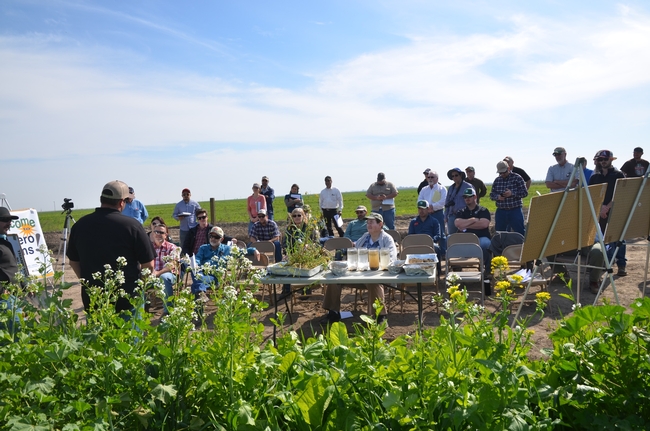Cover Crop Mixtures Showcased in Los Banos
With only five years of experience with cover crops under their belts, Danny Ramos and Jonathan Guido of Lucero Farms in Los Banos, have come quite far in terms of learning to manage cover crops to achieve considerable advantage in their processing tomato production systems. They shared their cover crop knowledge and experiences with a group of about forty visitors at a field day held on February 26th in one of their 2015 tomato fields just south of Hwy 152.
Ramos and Guido count on a number of “systems benefits” from their use of cover crops including better overall soil tilth via cover crop-derived inputs of carbon, better water movement throughout their 60-inch drip-irrigated tomato beds, and this year, - they are actually making money from the sale of the above ground portion of their cover crops to a nearby dairy as silage.
Ahead of their 2015 tomato crops, they've grown various mixes of cover crops that range from their standard triticale, mustard and vetch blend, to five very diverse mixtures including triticale-, rye-, barley-, and black oats-based, - and an especially high diversity mix of sixteen species.
In the field day that they hosted with Jeff Mitchell of the CASI (Conservation Agriculture Systems Innovation) Center at UC Davis, they talked about how they managed their 2015 cover crops and what they are hoping to get from them. Each of the mixtures was drill-seeded last October on the tops of their tomato beds, - not in the furrow bottoms, at rates ranging from 60 to 70 lbs/acre. They sprinkler-irrigated their fields as pre-irrigation ahead of this year's tomato crop and said that they applied only one and a half to two inches of additional water for the cover crops. After chopping and removing the above ground materials for silage that is going to a dairy in the Chowchilla area, they will run a strip-tiller to till the centers of their beds and to apply herbicide, before transplanting tomatoes. Later during the tomato season, they'll shallowly work in the remaining cover crop stubble during one of their weed cultivation operations.
Long-term research conducted by a team of UC researchers in Five Points has shown that cover crops, - and particularly cover crops coupled with no-tillage practices, - have increased soil carbon from about 8.8 tons/acre at the start of the study in 1999, to about 12.9 tons/acre in the top foot of soil after eight years.
Further information on the February 26th cover crop field day is available at the CASI website (http://casi.ucanr.edu/) and by viewing a summary video available at https://www.youtube.com/watch?v=V00CaEqUbE8&feature=em-upload_owner

